Contribute information about spots
Add Spot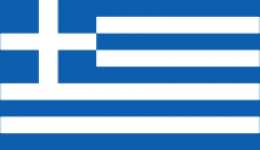
Kitesurfing in Greece
Greece, having the longest coastline in Europe and more than two thousand islands is also a place where theater, philosophy, democracy, and sporting competitions were born. The entire country is like an open-air museum. You will be amazed at the fabulous architecture and heritage of Greece, not to mention its rich gastronomy.
HIGHLIGHTS OF GREECE
HISTORY, ART AND CULTURE
Greece is a land rich in history, art, and culture, and its people are particularly attached to their traditions. Democracy, the Olympic Games, and philosophy, myths, and Greek theater have left important marks of their greatness throughout the country. Temples and theaters are some of the most remarkable buildings that remain. The museums of Greece are numerous and of great importance too, as are the archaeological sites—the most important of which are the Acropolis and its museum, the Agora of Athens, the National Archaeological Museum of Athens, and the Oracle of Delphi.
COFFEE
Coffee is the national drink. In the winter Greeks drink a lot of hot coffee for obvious reasons, but in the summer you can enjoy famous Greek frappés, which are basically coffee with ice. All in all, Greeks do drink coffee all the time, no matter the hour of day or the time of the year.
OLIVE PLANTATIONS
Since Ancient Greece the olive tree gained importance, making Greece one of the Mediterranean countries with the longest tradition in the processing of table olives with some 600 varieties for local use (and are frequently consumed outside the country, too).
BLUE ROOFTOPS
The architecture of the Cyclades is characterized by whitewashed houses, usually accompanied by blue doors, windows, and roofs matching the country's flag and in harmony with the clear blue sky and the vast Aegean Sea.
Also Greeks, being superstitious, believe that typical dome-shaped roofs of intense blue color scare away the evil eye (according to tradition).
KITESURFING IN GREECE
Almost everywhere in Greece, you can find great places to kiteboard, both near Athens and with a trip to the islands. There are not just one but three seashores—the Mediterranean, the Aegean, and the Ionian. The islands of Ionia, Rhodes, Corfu, Kos and Crete are a true paradise for kitesurfers. These islands are considered to be the best places for beginners and professionals alike.
A special mention should go to Rhodes, which has many great spots and is adored by advanced kitesurfers due to a combination of strong winds and waves.
Beginners are advised to start exploring the coasts of Lemnos. In the summer, there is a constant mild wind and the water warms up as well.
In the majority of the islands there are equipment rental points and schools. Amateurs can take part in instructor-led sessions, while professionals can conquer the waves and, if needed, rent some equipment.
The climate allows you to enjoy the sea and the sun from May to the end of September, but in July and August the winds are at their strongest (the Meltemi), while in September you get the perfect combination for kitesurfing—calm, warm water with moderate winds.
And indeed, there is no better place to kite in September than Greece in Europe, as the summer season extends. Warm seas, mild sunshine, scenic views, many beautiful beaches and ideal winds—nothing more is needed, it’s total perfection.
WHEN IS THE BEST TIME TO KITESURF IN GREECE?
Greece has a Mediterranean climate with mild winters and hot summers. The hottest months are from June to August when temperatures soar above 30°C during the day and 20°C at night. The coldest months are January and February.
The main kitesurfing season in most Greek islands runs from May to September. This is due to water temperature, wind direction, and wind strength. However, the summer months see an influx of tourists (also, the heat may be unbearable). So the spring and autumn season is more suitable for all those who wish to avoid the noisy crowds of tourists. Autumn in Greece occurs quite late, so in September the weather typically remains summary. But take note that the wind probability is lower than in the summer months, and the spring and autumn bring more rainfall.
WHAT ARE THE BEST KITESURF SPOTS IN GREECE?
Naxos
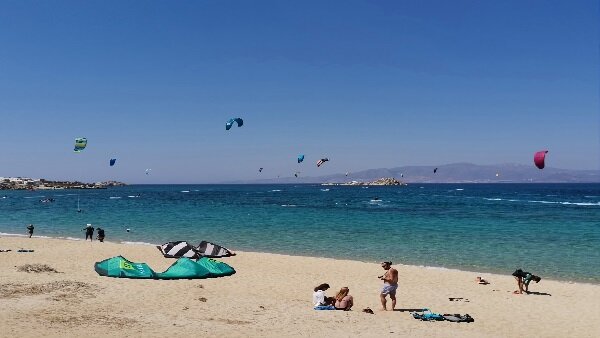
Photo: Kite Center Naxos by Thalasea Sports
From the end of May to mid-September the ‘’Meltemi’’ wind rocks the Cyclade islands and Naxos and becomes a must-visit for kitesurfers. The bay of Mikri Vigla is a great kite spot and is always packed with kitesurfers. If you find the beach too busy, the beach of Glyfada remains preserved with a long stretch of fine sand.
Limnos
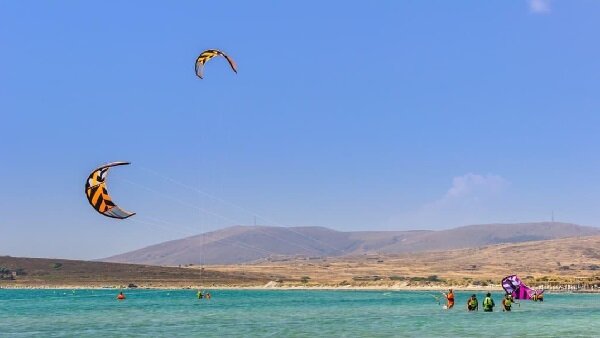
Photo: Surfclub Keros
Limnos is another beautiful island with green landscapes on a volcanic background; a preserved and peaceful island. It has a beautiful beach with flat and shallow water in the north, and if you feel like you desire waves, you will find them at the tip of the bay. The island is preserved from mass tourism, therefore, the spot is still not very crowded. The wind is constant and the setting is nothing but superb.
Kos
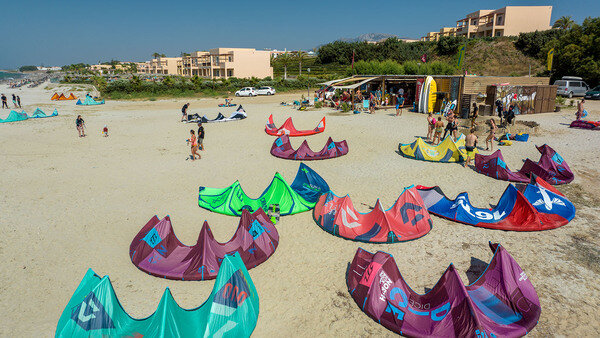
Photo: Horizon Surfing Center Kos
The island of Kos, located just off the coast of Turkey offers strong winds from the end of June to the end of August. In the northernmost part of the island, you have the spot of Marmari offering choppy water and some waves when the wind rises. In the northeast you have a spot of Psalidi which is one of the most loved and frequented spots. It has a well-developed infrastructure on the beach for kitesurfers. And then you have Kohilari spot, in the southwestern part of the island. The wind is generally a little less strong, however, the area is huge with choppy water which makes the kitesurfing pleasant.
Crete
What makes this island so fascinating is that each region is different, so everyone who comes here will find what they like best. The mountains, the beaches, the olives, the delicious octopus, and the hospitality of the locals will accompany you during your stay on the island. Also, Crete has all the conditions for kitesurfing. The wind-water sport is popular here from June to September. The best place to go in Crete is on the eastern edge of the island of Palaiokastro where the bay is ideal for beginners and professionals.
Rhodes
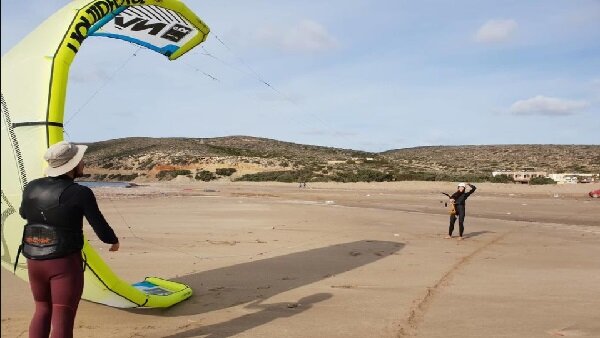
Photo: Wetskillz kitecenter
Rhodes is closer to Turkey than mainland Greece and is quite windy—a favorite among kitesurfers. The southern side of Rhodes is quieter, less populated, and a little less touristy. The autumn season is, therefore, the best season for anyone who wants to avoid the noisy crowds devoting their holidays to beating the waves. The most popular spot, Prasonisi, is the place that attracts the majority of kitesurfers. Experienced kiters prefer the second half of the day, which is when the wind is at its best, speeding up to 20 knots.
Paros
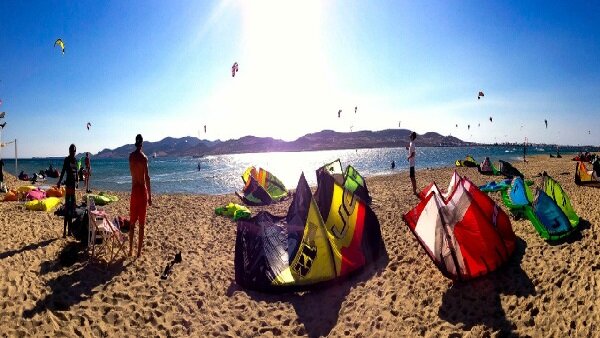
Photo: Paros Kite Pro Center
The kitesurfing season here runs from May to October. The beach in New Golden is a favorite destination for lovers of wind and water sports. For beginners who are just starting to master the basics of kitesurfing, Pounda Beach is the best place to go, as it is a small strait of 1.7 kilometers that separates the island of Antiparos from the coast. Here, a venturi effect is created and the ‘’Meltemi’’ blows between 12 and 25 knots.
Mykonos
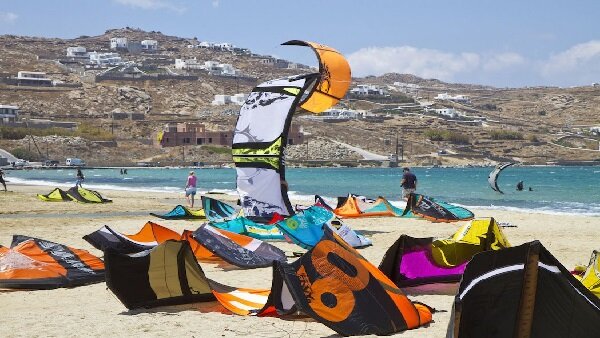
Photo: Kite Mykonos
The island of Mykonos is a natural paradise because of the number of beaches and night parties. It is also a windy island, especially in the northern part. Kalafatis beach is the ideal beach for the most sporty people. The beach is usually very exposed to the wind and allows kitesurfing on most days. In fact, on the same beach, you can rent all kinds of kitesurfing equipment. Other important beaches are Ftelia and Korfos Bay.
Nea Kios
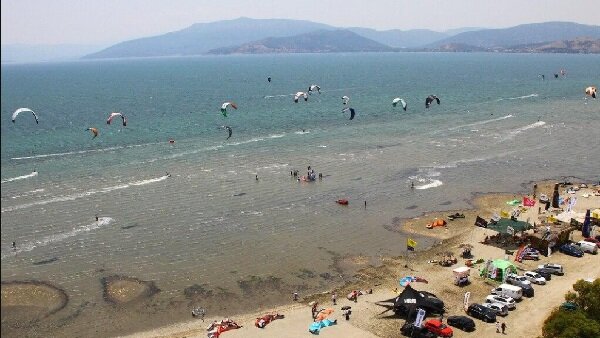
Photo: Radical Kite Center
The kitesurfing spot is well known for its proximity to the capital. It serves as a gateway from busy Athens to enjoy the sport. The conditions are great for beginners as the water is shallow, flat, and sometimes choppy. In addition, there is plenty of space on the beach to launch and land the kite. The best season is considered to be from April to September (with thermal winds in summer). Apart from kitesurfing, the neighboring town of Nafplio has great nightlife with a number of dance clubs.
Drepano
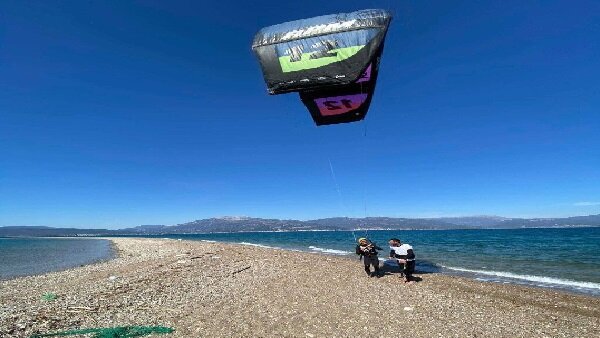
Photo: Cape Drepano Watersports
Cape Drepano is one of the few kite spots in Greece that is specially designated as a kite beach. Cape Drepano is a long, narrow headland that stretches into the Gulf of Corinth. The fairly wind-safe kite spot works in both westerly and easterly winds. The kite spot is not only popular with locals and tourists, but also well-known kitesurfing athletes.
Lesvos
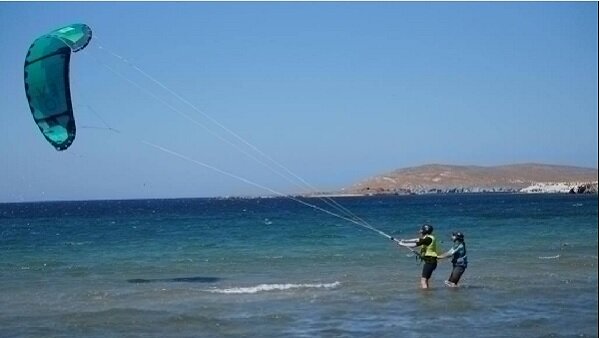
Photo: Extrados Kite Activity
The third largest Greek island, Lesvos, is just as windy as the other islands swept by the ‘’Meltemi’’, and yet more authentic and preserved from the crowd. The Sigri spot offers excellent conditions with a wind that increases from morning to afternoon: getting up to 25 knots at midday. You can kite there safely from beginner level to the free-rider, the freestylist or the foilist.
ABOUT THE COUNTRY
A Brief History of Greece
Stone Age farmers lived in Greece as early as 7,000 BCE.
But later, the most important civilization of ancient Greece was the Minoan. Around 2,500 BCE this sophisticated society grew up on the island of Crete.
However, it was during the Archaic period (VIII B.C.E.-VI B.C.E.) when the Greek cities (polis) and the most characteristic features of their identity developed. The period of maximum political, economic, and cultural splendor was reached during the Classical Period. During this period, the Century of Pericles (V B.C.E.) took place when the Parthenon and other symbols of Athens were built.Also in this stage, the theater reached its greatest apogee. In the 5th and 4th centuries BCE Greece excelled in architecture, sculpture, and literature. They also produced some of the world's greatest philosophers and mathematicians—and also gave us the Olympic Games.
Alexander the Great was the figure who consolidated the Greek territories. He led an army into what is now Turkey in 334 BCE. He crushed the Persians at the Battle of Issus in 333 BCE and conquered a vast empire stretching from Egypt to India. However, Alexander died in 323 BCE and his empire was broken. Nevertheless, Greek culture spread throughout the Middle East.
From the 15th to the early 19th century, Greece was ruled by the Ottoman Turks. The Ottoman Empire was at its peak in the 16th century. However, from the end of the 17th century, it slowly declined and, by the end of the 18th century, nationalism grew in Greece.
Eventually, the European powers intervened and a French, British, and Russian fleet destroyed the Turkish fleet at the Battle of Navarino in 1827. Greece finally became independent in 1829.
In 1896 the Olympic Games were revived.
When World War I began in 1914, Greece remained neutral at first, but in 1917 joined the Allies.
The Germans invaded Greece on April 6, 1941. They captured Athens on April 23. Greece was then occupied by Germans and Italians. The Greeks suffered terribly during World War II and many starved to death.
In 1981 Greece joined the EU. In 2001, Greece joined the euro.
Other Attractions in Greece
Greece has a wide range of attractions. There is just too much to do, visit, and see.The Meteora Monasteries are a must to see and will take your breath away—it’s a religious site with a mystical landscape where the patterns of sandstone cliffs and the tranquillity of 300 meters of altitude converge. It is one of the most photogenic places in Greece.
Also, Mount Olympus is the seat of the gods of Greek mythology. It is the highest mountain in all of Greece and one of the highest in Europe. The Mount Olympus mountain range is not only remarkable for its size, but also for its amazing fauna and endemic species.
The Valley of the Butterflies is a real natural highlight of Rhodes for romantics. Don't miss the chance to walk through the multicolored butterfly-covered vegetation with the roaring waterfalls in the background.
Finally, Navagio Beach is the calling card of Zakynthos, a paradise on earth. Apart from the bright white sand and the turquoise Ionian Sea framed by steep cliffs, a sunken smuggler's ship can be found washed up on the beach.
Getting to Greece
Greece has numerous airports. The Athens International Airport is the largest airport in the country. Other international airports with major traffic are Heraklion, Thessaloniki, Rhodes, or Corfu. Athens and Thessaloniki handle the majority of international scheduled flights. And yet, during the tourist season, many low-cost carriers also have domestic flights to the Greek islands and smaller airports.
In regards to international rail service, Thessaloniki is Greece's hub. Trains connect Thessaloniki to Sofia, Bucharest, Budapest, Istanbul, and other international cities. In summer there are direct services to Prague, Bratislava and Moscow. There are special fares for train travel in Europe.
You can also reach Greece by car via neighboring countries. From Italy, ferries transport cars to Greece. From Europe, the most popular route is through Eastern European countries.
Going by bus is also an option as there are some, although limited international buses from neighboring Albania, Bulgaria, and Turkey, as well as from Georgia.
Arriving in Greece by boat is the best option if you wish to take a Mediterranean cruise or a transfer from Italy, Cyprus, Turkey, or Croatia, which is recommended especially during the summer and spring. The maritime network in Greece is particularly extensive and guarantees transport to all the islands of the Greek territory. Its internal maritime transport, high-speed ferries, make numerous trips. Most of the trips have occur daily throughout the year.
USEFUL RESOURCES
SIMILAR KITESURFING DESTINATIONS
- Italy
SPOT
WORLD > EUROPE > GREECE > NAXOS
NAXOS
Naxos is a spot very well known amongst kitesurfers for its great conditions. The choppy water is ideal for freeride and also for good bump and jump sessions in the open sea where the swell is very present. It is on the west coast of Naxos that you will have the most wind—the thermal wind from the North blows all day long with an average strength of 20 knots.
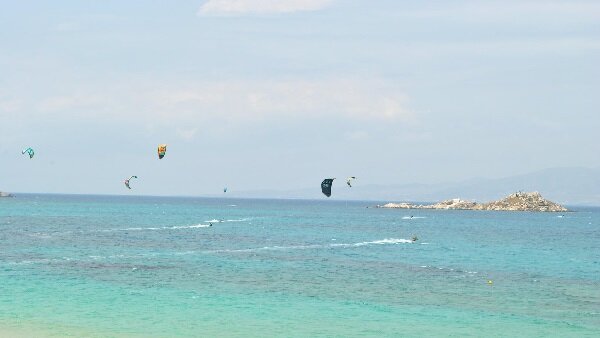
Photo: Flisvos Kitecenter Naxos
HIGHLIGHTS
REMOTE BEACHES
One of the best partss of the island is its beaches. The island of Naxos has more than 100 kilometers of large sandy beaches. Remote places with few tourists and turquoise waters that you will not want to leave are what await you on the coastline. Some of the most beautiful ones are Hawaii Beach, Agios Prokopios, or Apollonas.
CYCLADIC ARCHITECTURE
Chora is the capital of Naxos and everything you want to know about Cycladic architecture you will find there. Whitewashed white houses with blue-painted doors and windows, small chapels, stone-paved roads, arches, and endless cobblestone alleys make this labyrinth so charming.
ICONIC SUNSETS
For sunset fans who always try to find the best spots, the most famous in Naxos is the one from the Temple of Apollo. The gate is the only remaining part of the temple, however, it is one of the most photogenic places on the island.
Another unforgettable sunset spot is from Hawaii beach, where you can witness how the colors of the rocks are changing as the sun goes down.
CULTURAL FESTIVALS
In Naxos, you may enjoy many traditional festivals that attract internationally renowned musicians, dancers, and actors. For this reason, Naxos has become a favorite summer destination for lovers of the arts. From classical, modern, and jazz music, to painting and sculpture exhibitions, lectures, and seminars, you can find it all here. These events create a very interesting cultural mosaic which impresses not only the locals but also foreign visitors.
KITESURFING IN NAXOS
Naxos, as the largest island of the Cyclades, forms the center of the archipelago and is also a hub for kitesurfers. It is separated only by a narrow strait from the neighboring island of Paros through which the ‘’Meltemi’ (Greek trade wind)’ accelerates considerably. In Naxos, the more you go south, the more the beaches follow one another, the more you feel the peace and quiet. The colors gain in contrast, the mountains rise, and the ’Meltemi’ strengthens.
The spot at Agios Georgios is one of the few good wave spots for kitesurfing in the Aegean Sea. The ‘Meltemi’ pushes the swell through the strait between Naxos and Paros and so you have an onshore wind and up to 2 meters of clean waves (which invites you to have some jumps). What makes the spot especially attractive is that right next door and behind a reef a huge lagoon with shallow water begins, which also offers the best conditions for freeriders and beginners.
Further south, in Mikri Vigla there are great conditions for kitesurfing. At the local kitesurfing schools, you can easily rent equipment and book kitesurfing classes with a certified instructor. The fine sandy beach is wide and offers plenty of space, which makes this spot the number 1 kiting area on Naxos. The further out you kitesurf, the higher the waves become, whereas, at the entrance, there is almost flat water.
Wind, weather and water
The ’Meltemi’ blows from May to October with particular intensity between June, July, and early September. ’Meltemi’ winds are strong, dry, seasonal winds that occur throughout the Aegean. Depending on where you are in Greece, they can come from the north, northeast, or northwest. The ’Meltemi’ helps lower the scorching summer temperatures and clears the atmosphere, providing great visibility. If it weren't for the ’Meltemi’, temperatures in the Aegean would be much higher. The channeling of the wind between the islands causes its speed to increase.
Mikri Vigla, located on the southwestern part of the island, benefits fully from the venturi effect generated between the islands of Paros and Naxos. This spot, with a main wind direction side onshore, is rocked by a light wind in the morning that strengthens at the end of the morning to reach its full force in the afternoon.
Greece enjoys a temperate Mediterranean climate. In the summer the days are long and the temperatures are high. Often, at the end of the day, there can be a cooling breeze—especially in the coastal areas and in the north of the country. On summer days it gets quite hot on the mainland, with temperatures oscillating between 25 and 30 degrees. Athens can reach up to 42ºC. However, on the islands, it is less hot. The rainy season lasts from November to March.
The water temperature is average, so a short sleeve wetsuit can provide more comfort and sun protection if you intend to surf for a long time. Some areas have flat, choppy water, while others will have waves up to 2-3 meters in height.
WHAT ARE THE BEST BEACHES FOR KITESURFING IN NAXOS?
Mikri Vigla Beach
Over the years, kitesurfing has established itself on the spot of Mikri Vigla to finally become the main spot on the island of Naxos. Being 18 kilometers from the capital, the area of Mikri Vigla has remained authentic. The natural beauty of the landscapes is very appreciated by the kitesurfers who come to recharge their batteries. It is a nice spot that consists of a wide beach of golden-white sand, perfect in terms of safety, as it is enclosed in a bay. More so, you can make long rides between the beach of Mikri and the small rocky island of Parthena.
In summer, the wind is strong, matching the effects of the ’Meltemi’. This wind during the summer starts in the early morning and stops at sunset. The beginning of July or the end of August offers easier conditions for beginners, therefore, you will not be alone on the water.
Wind direction: N-NE, constant, on average 20 knots and more.
Water conditions: chop, small waves, crystal clear water, water temperature between 19 and 25 degrees.
Discipline(s): freestyle, big air, freeride.
Skill level: all levels
Watch out for: (hazards) rocks near the island
Getting there: about 20 minutes south of Naxos town by car, but there is also a direct bus departing from Naxos and arriving at Mikri Vigla. Buses depart four times a day and operate daily with a journey time of approximately 17 minutes.
Tip: the wind is often very strong in high season, plan on small kite sizes.
TRAVELING TO NAXOS AS A KITER
Getting There
Naxos has a small domestic airport with direct domestic flights to Athens airport. Therefore, you can fly to Athens and from there travel by plane or ferry to Naxos. This option is not always the most convenient. Planes departing from Athens to Naxos are small with a maximum of 50 passengers.
Also, Naxos is very close to Mykonos and Santorini, both islands with international airports and ferries arriving at Naxos. So the best option to get to Naxos from Europe is to take a direct flight to Mykonos or Santorini and from there travel by ferry. Mykonos is the closest location to Naxos and therefore takes less time by ferry, whereas from Santorini the ferry takes from 1.5 to 2.5 hours depending on the boat and the route.
Accommodation
Naxos is an island that offers many apartments and family-run accommodation. There are also few large resorts or big hotels for maximum comfort. The best place to sleep in Naxos is Chora. In the capital of the island, you will have access to more amenities and several beaches nearby. Chora is also great if you want to go out for drinks or have fun at night.
Agios Georgios, located just steps from Chora, is another good place to stay and enjoy the beach all day then walk into the town of Chora for a sunset drink or dinner.
Another area to overnight is Agia Anna, thanks to its beautiful beaches protected from the wind with turquoise waters, golden sand, and a variety of restaurants and fun beach clubs.
The best places to live like a local are the mountain villages, especially Chalki, Moni, Sangri, and Filoti, which offer modern comforts and excellent locally sourced food in a picturesque setting.
Other small villages worth mentioning are Moutsouna, Kalandos, and Apollonas—all far from Chora, yet quiet and with few tourists.
Getting Around
Naxos is an island with many beaches and places worth visiting, so if you want to travel around the island and reach all the remote spots, the best is to rent a car or a scooter and explore the region on your own. This is the most expensive option, but also the most comfortable, since you do not have to depend on bus schedules so you can go anywhere at your own pace.For short distances you can take a taxi or a local bus. However, the fact that Naxos isn’t that touristy also has its disadvantages, as the public transport is not so good.
Food and Drink
Naxian food is famous all over Greece. Naxos is particularly known for its potatoes, citrus fruits, kitron (a citrus-based liqueur), cheeses, lamb and goat, wine grapes, honey, and fresh fish. Chora town has the most restaurants and almost all the bars in Naxos. Most of the restaurants in Chora are located along the harbor or inside the old labyrinthine village. The restaurants along the harbor have incredible sunset views, but the food is usually better inside the town. Traditional dishes to try are Paidaki—goat or mutton ribs with lemon, oregano, salt and pepper; Sfakiano—lamb stewed in wine with spices; and psaria plaki—fried fish with vegetables and tomato, fennel, olive oil sauce.
The country has been producing wine for thousands of years and offers some truly amazing varieties, especially white wines. The main wine regions of Greece are, in fact, the Cyclades (the group of islands including Naxos). Types to try include Assyrtiko and Moschofilero (both whites), Agiorgitiko (rosé and red), Xinomavro (red), and Vinsanto (white dessert wine).
Don’t forget the delicious puff pastry—baklava.
No Wind?
The island is too beautiful and singular not to go and discover it. The distances are very reasonable, and the roads very pleasant. The landscapes pass by and do not resemble each other. Everything is a pretext for a stop: a small mountain chapel, a traditional village, a sunset with a little height.
The most beautiful beaches of the island are considered to be in the southwestern part, including the bay of Mikri Vigla, and the beaches of Kastraki and Glyfada.
Also, do not miss the Portara, built from the ruins of an ancient temple.
Discover Agia Anna, a small family resort during the day with its restaurants and cafes on the waterfront, which becomes a lively place in the evening.
There are more than 500 churches and chapels on the island as well as many medieval castles to visit.
Like all the best historic centers, the old town of Naxos is a place where you can wander idly for hours and has irregular marble cobblestones and beautiful white Cycladic houses. Kastro is a confusing little world of alleys, stairways and passages which is worth your attention too. Many of these have doors, railings and window frames painted deep or pale blue.
The geography and mythology make Naxos one of the best places in the Cyclades for hiking. Go to meet Naxos secret coves. There are two reasons to hike Mount Zas: to stand on the highest point of the Cyclades and to reach the top of the mountain where Zeus was born and raised. Hidden in the slopes of the mountain is a small cave where Zeus was born. You can visit this cave while walking to the top.
Finally, enjoy Greek cuisine on a mountain path or in the evening facing the sunset on the roof terraces of the restaurants of the city.
USEFUL RESOURCES
Best Season
Depending on which location you choose to visit in Greece the recommended season will be between May to August. Some people try to make trips either early or later in the season as it can get very crowded in the middle of the season. You have about 8 months of strong winds in Greece a year.

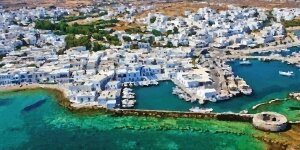

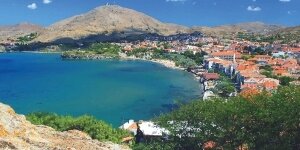
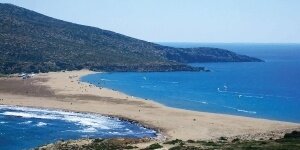
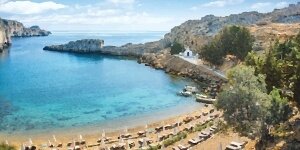
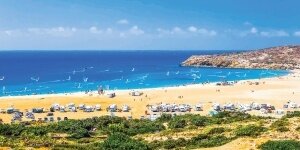
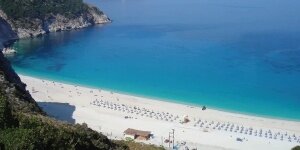
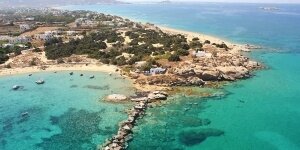
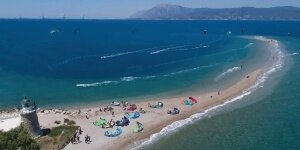
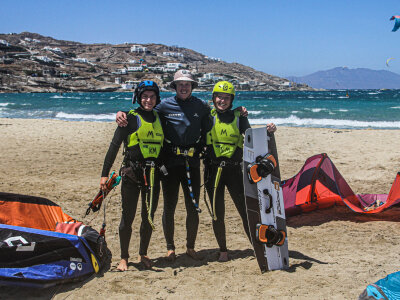
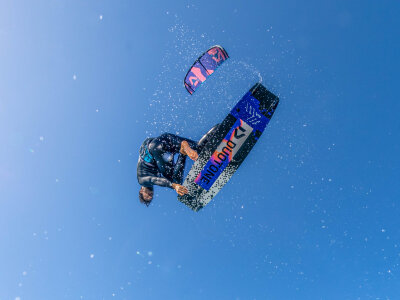
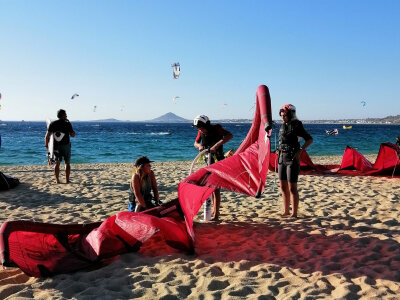

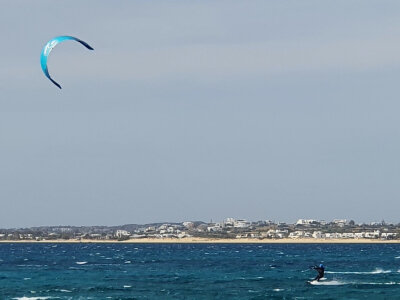
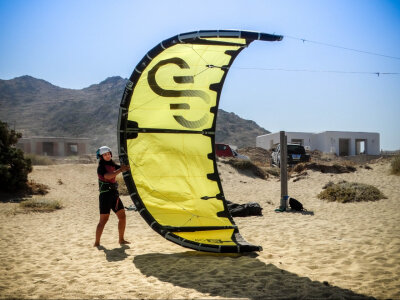

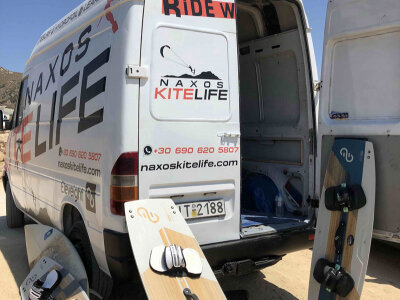
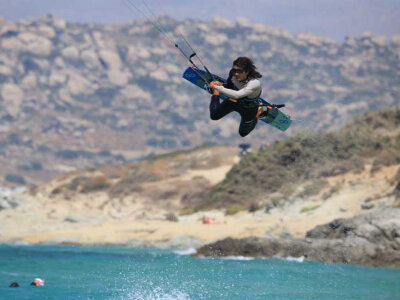
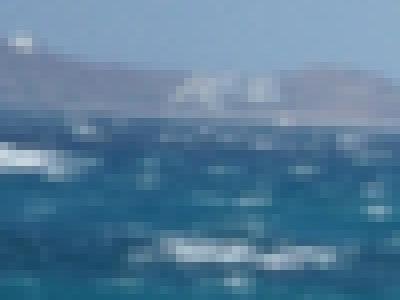
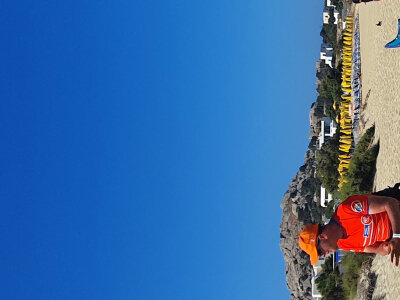
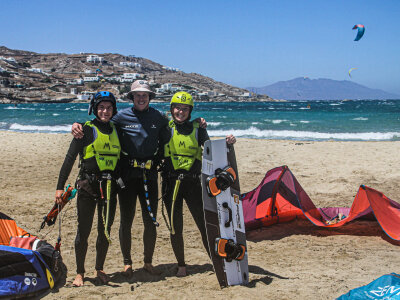

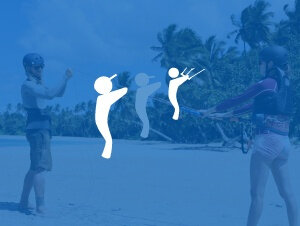
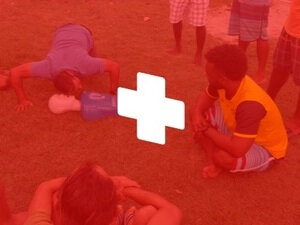
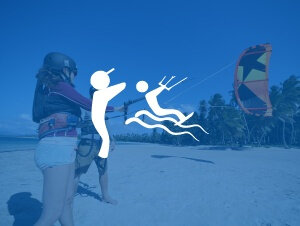
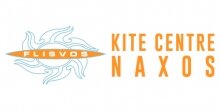







.png)

